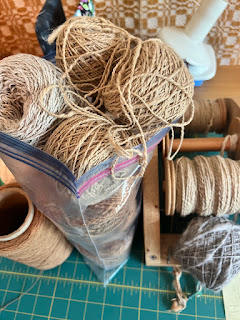Every day I learn something new--and I'm glad I do! Take Fustian Cloth and Cutting--I didn't know what that term meant until I came upon an article and video about Fustian. I'm very familiar with velvet, corduroy and other welted fabrics, I did not know about Fustian cutting.
Video is worth watching to understand about this technique.

Early in the 16th century, towns in South Lancashire had a reputation for making cotton
goods, in reality these good were made mainly of wool with a small mixture of linen, both
constituents being home grown, whilst cotton had to be imported.
Large numbers of Flemish weavers had settled in Manchester and surrounding areas to
escape persecution in their own land. They were the first to use cotton imported from India
and Asia Minor.
To evade laws passed to protect the woollen manufacturers, the Flemish weavers mixed
linen in with cotton and this material was the starting point for fustian that was used in the
district up until the beginning of the 20th century,
Cadishead is best known for fustian cutting, by the 1870’s it would have been well nigh
impossible to find a house without a cutting frame or a family unconnected with cutting.
Fustian cutting is an operation in the manufacture of velvet and involves cutting by hand of
loops woven into the cloth to create the pile.
The basic requirements were a frame on which to spread the cloth to drum tightness, and a
knife to cut the loops of the cloth. The frame was about 6ft by 2ft6ins wide and 3ft high.
The knife was around 18inches long it had a wooden handle and the tip was drawn out to a
sharp point which was ground to a sharp edge at the top.
The cloth was brought by horse and cart from warehouses in Salford and Manchester it was
woven to give continuous tunnels along the length of the material. The pile was created by
the cutter passing a knife through the tunnels cutting the threads at the centre of the
arch. There were between thirty to forty of these tunnels per inch so one can imagine the
skill and concentration required.
Most of the family would take part in the operation with the women working the frames in
spring and summer whilst the men were working on the farms. The men would take over in
the winter months when there was not a lot of work elsewhere.
Around 1770, fustian cutting was carried out mainly in farm workers cottages. By 1840
terraced houses were being built with cutting shops built on the end. This followed on from
farm houses that had stables attached to them which had been modified for fustian cutting
By 1860 two storey terraced houses were being built with the attic built to house the
cutting frame. The attic in Academy Row, Cadishead is set at the back of the terrace, giving
a lop-sided appearance to the gable end. The higher part of the gable end would face
towards the south to get the most light. The attic would run the whole length of the
terrace, but could only be accessed from the end house.
By the end of the nineteenth century mill- type structures of three stories were being
built. These buildings showed the change from cottage craftsmen to factory tradesmen. A
good example of one of these buildings is the building opposite the Ship Hotel in Irlam.
Along with these factory type buildings a new longer frame was developed. These frames
could be up to 12 yards long and the operator would walk along the length of the frame. The
worker would be walking around twenty miles a day. As the fustian could only be cut in one
direction the cutter would have two frames and would walk up one and down the other,
totalling around twenty miles a day - twenty miles of precision cutting.
In the 1870’s and 80’s fustian cutting was at it’s peak, the master cutters with an eye to
business would convert a portion of their cutting shops into grocers, green grocers and
shops of other trades, paying wages one day and then taking it back the next.
New industry was brought into the district through the building of the Manchester Ship
Canal at the end of the 19th century and young workers were attracted to these industries
with the lure of better pay and better working conditions.
The industry of hand –cutting was finally doomed by the invention of machinery to do the
job. The machines could cut fustian ten times quicker than a hand cutter. These machines
were introduced just before the First World War even though hand cutting went on in
Cadishead until 1928.
For more information on Fustian cutting, Irlam and Cadishead Local History Society











